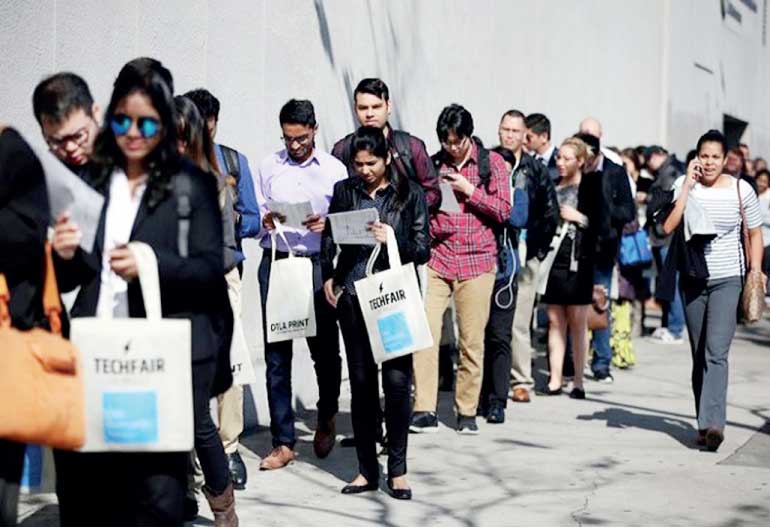Friday Mar 07, 2025
Friday Mar 07, 2025
Monday, 5 June 2017 00:01 - - {{hitsCtrl.values.hits}}

WASHINGTON (Reuters): US job growth slowed in May and employment gains in the prior two months were not as strong as previously reported, suggesting the labour market was losing momentum despite the unemployment rate falling to a 16-year low of 4.3%.
Nonfarm payrolls increased 138,000 last month as the manufacturing, government and retail sectors lost jobs, the Labour Department said on Friday. The economy created 66,000 fewer jobs than previously reported in March and April.
Last month’s job gains could still be sufficient for the Federal Reserve to raise interest rates at its June 13-14 policy meeting. The economy needs to create 75,000 to 100,000 jobs per month to keep up with growth in the working-age population.
“While the message was a little muddied today, the evidence generally suggests the labour market is cyclically tightening, and the Fed will need to continue to lean against that,” said Michael Feroli, an economist at JPMorgan in New York.
“We still believe it is very likely that the Fed will hike later this month. Perhaps more in question is the signal coming out of that meeting regarding subsequent hikes.”
Details of the employment report were weak. Though the unemployment rate fell one-tenth of a percentage point to its lowest level since May 2001, that was because 429,000 people dropped out of the labour force.
The survey of households from which the unemployment rate is derived also showed a drop in employment. The jobless rate has declined five-tenths of a percentage point this year.
Average hourly earnings rose 4 cents or 0.2% in May after a similar gain in April, leaving the year-on-year increase in wages at 2.5%.
Job growth has decelerated from the 181,000 monthly average over the past 12 months as the labour market nears full employment. There is growing anecdotal evidence of companies struggling to find qualified workers.
Economists also believe that companies might be holding off hiring amid worries political scandals engulfing President Donald Trump could imperil his economic agenda, including tax cuts and infrastructure spending.
“Political uncertainty in Washington is another factor holding back the job market,” said Sung Won Sohn, an economics professor at California State University Channel Islands in Camarillo. “The probability that any of the Trump stimulus would become reality has decreased significantly in recent weeks.”
Economists had forecast payrolls increasing 185,000 last month and the unemployment rate holding steady at 4.4%.
The Fed raised interest rates in March. A Reuters survey of banks that do business directly with the Fed, conducted after the employment report, showed all 18 primary dealers polled expected the US central bank to raise rates this month.
Ten forecast further monetary policy tightening in September and only six saw a rate hike in December.
The dollar hit a seven-month low against a basket of currencies on the diminishing rate hike prospects in the second half of the year. Long-dated US Treasury yields fell to nearly seven-month lows, and short-dated yields touched their lowest in more than two weeks. US stocks closed at new highs.
Discover Kapruka, the leading online shopping platform in Sri Lanka, where you can conveniently send Gifts and Flowers to your loved ones for any event including Valentine ’s Day. Explore a wide range of popular Shopping Categories on Kapruka, including Toys, Groceries, Electronics, Birthday Cakes, Fruits, Chocolates, Flower Bouquets, Clothing, Watches, Lingerie, Gift Sets and Jewellery. Also if you’re interested in selling with Kapruka, Partner Central by Kapruka is the best solution to start with. Moreover, through Kapruka Global Shop, you can also enjoy the convenience of purchasing products from renowned platforms like Amazon and eBay and have them delivered to Sri Lanka.
Discover Kapruka, the leading online shopping platform in Sri Lanka, where you can conveniently send Gifts and Flowers to your loved ones for any event including Valentine ’s Day. Explore a wide range of popular Shopping Categories on Kapruka, including Toys, Groceries, Electronics, Birthday Cakes, Fruits, Chocolates, Flower Bouquets, Clothing, Watches, Lingerie, Gift Sets and Jewellery. Also if you’re interested in selling with Kapruka, Partner Central by Kapruka is the best solution to start with. Moreover, through Kapruka Global Shop, you can also enjoy the convenience of purchasing products from renowned platforms like Amazon and eBay and have them delivered to Sri Lanka.